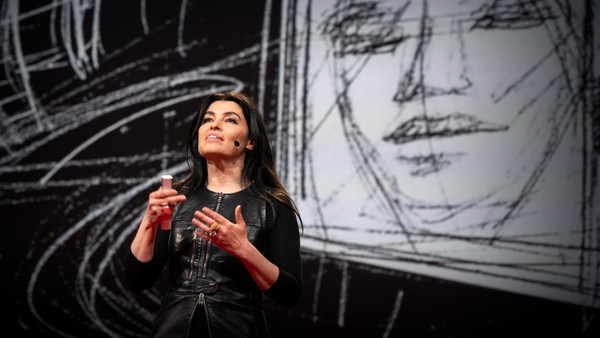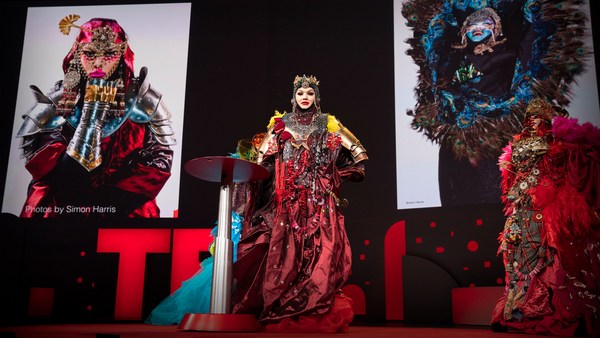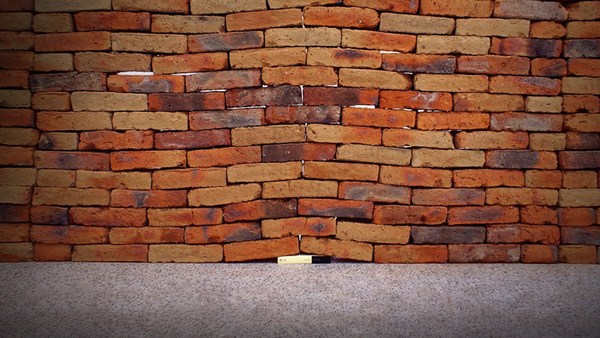I want to start with a question. Where does an artwork begin? Now sometimes that question is absurd. It can seem deceptively simple, as it was when I asked the question with this piece, "Portable Planetarium," that I made in 2010. I asked the question: "What would it look like to build a planetarium of one's own?" I know you all ask that every morning, but I asked myself that question. And as an artist, I was thinking about our effort, our desire, our continual longing that we've had over the years to make meaning of the world around us through materials. And for me, to try and find the kind of wonder, but also a kind of futility that lies in that very fragile pursuit, is part of my art work.
So I bring together the materials I find around me, I gather them to try and create experiences, immersive experiences that occupy rooms, that occupy walls, landscapes, buildings. But ultimately, I want them to occupy memory. And after I've made a work, I find that there's usually one memory of that work that burns in my head. And this is the memory for me -- it was this sudden kind of surprising experience of being immersed inside that work of art. And it stayed with me and kind of reoccurred in my work about 10 years later.
But I want to go back to my graduate school studio. I think it's interesting, sometimes, when you start a body of work, you need to just completely wipe the plate clean, take everything away. And this may not look like wiping the plate clean, but for me, it was. Because I had studied painting for about 10 years, and when I went to graduate school, I realized that I had developed skill, but I didn't have a subject. It was like an athletic skill, because I could paint the figure quickly, but I didn't know why. I could paint it well, but it didn't have content. And so I decided to put all the paints aside for a while, and to ask this question, which was: "Why and how do objects acquire value for us?" How does a shirt that I know thousands of people wear, a shirt like this one, how does it somehow feel like it's mine?
So I started with that experiment, I decided, by collecting materials that had a certain quality to them. They were mass-produced, easily accessible, completely designed for the purpose of their use, not for their aesthetic. So things like toothpicks, thumbtacks, pieces of toilet paper, to see if in the way that I put my energy, my hand, my time into them, that the behavior could actually create a kind of value in the work itself. One of the other ideas is, I wanted the work to become live. So I wanted to take it off of the pedestal, not have a frame around it, have the experience not be that you came to something and told you that it was important, but that you discover that it was in your own time.
So this is like a very, very old idea in sculpture, which is: How do we breathe life into inanimate materials? And so, I would go to a space like this, where there was a wall, and use the paint itself, pull the paint out off the wall, the wall paint into space to create a sculpture. Because I was also interested in this idea that these terms, "sculpture," "painting," "installation" -- none of these mattered in the way we actually see the world. So I wanted to blur those boundaries, both between mediums that artists talk about, but also blur the experience of being in life and being in art, so that when you are in your everyday, or when you are in one of my works, and you saw, you recognized the everyday, you could then move that experience into your own life, and perhaps see the art in everyday life.
I was in graduate school in the '90s, and my studio just became more and more filled with images, as did my life. And this confusion of images and objects was really part of the way I was trying to make sense of materials. And also, I was interested in how this might change the way that we actually experience time. If we're experiencing time through materials, what happens when images and objects become confused in space? So I started by doing some of these experiments with images. And if you look back to the 1880s, that's when the first photographs started turning into film. And they were done through studies of animals, the movement of animals. So horses in the United States, birds in France. They were these studies of movement that then slowly, like zoetropes, became film.
So I decided, I will take an animal and I'm going to play with that idea of how the image is not static for us anymore, it's moving. It's moving in space. And so I chose as my character the cheetah, because she is the fastest land-dwelling creature on earth. And she holds that record, and I want to use her record to actually make it kind of a measuring stick for time. And so this is what she looked like in the sculpture as she moved through space. This kind of broken framing of the image in space, because I had put up notepad paper and had it actually project on it. Then I did this experiment where you have kind of a race, with these new tools and video that I could play with. So the falcon moves out in front, the cheetah, she comes in second, and the rhino is trying to catch up behind.
Then another one of the experiments, I was thinking about how, if we try and remember one thing that happened to us when we were, let's say, 10 years old. It's very hard to remember even what happened in that year. And for me, I can think of maybe one, maybe two, and that one moment has expanded in my mind to fill that entire year. So we don't experience time in minutes and seconds. So this is a still of the video that I took, printed out on a piece of paper, the paper is torn and then the video is projected on top of it. And I wanted to play with this idea of how, in this kind of complete immersion of images that's enveloped us, how one image can actually grow and can haunt us.
So I had all of these -- these are three out of, like, 100 experiments I was trying with images for over about a decade, and never showing them, and I thought, OK, how do I bring this out of the studio, into a public space, but retain this kind of energy of experimentation that you see when you go into a laboratory, you see when you go into a studio, and I had this show coming up and I just said, alright, I'm going to put my desk right in the middle of the room. So I brought my desk and I put it in the room, and it actually worked in this kind of very surprising way to me, in that it was this kind of flickering, because of the video screens, from afar. And it had all of the projectors on it, so the projectors were creating the space around it, but you were drawn towards the flickering like a flame. And then you were enveloped in the piece at the scale that we're all very familiar with, which is the scale of being in front of a desk or a sink or a table, and you are immersed, then, back into this scale, this one-to-one scale of the body in relation to the image. But on this surface, you had these projections on paper being blown in the wind, so there was this confusion of what was an image and what was an object.
So this is what the work looked like when it went into a larger room, and it wasn't until I made this piece that I realized that I'd effectively made the interior of a planetarium, without even realizing that. And I remembered, as a child, loving going to the planetarium. And back then, the planetarium, there was always not only these amazing images on the ceiling, but you could see the projector itself whizzing and burring, and this amazing camera in the middle of the room. And it was that, along with seeing the audience around you looking up, because there was an audience in the round at that time, and seeing them, and experiencing, being part of an audience. So this is an image from the web that I downloaded of people who took images of themselves in the work. And I like this image because you see how the figures get mixed with the work. So you have the shadow of a visitor against the projection, and you also see the projections across a person's shirt. So there were these self-portraits made in the work itself, and then posted, and it felt like a kind of cyclical image-making process. And a kind of an end to that.
But it reminded me and brought me back to the planetarium, and that interior, and I started to go back to painting. And thinking about how a painting is actually, for me, about the interior images that we all have. There's so many interior images, and we've become so focused on what's outside our eyes. And how do we store memory in our mind, how certain images emerge out of nowhere or can fall apart over time. And I started to call this series the "Afterimage" series, which was a reference to this idea that if we all close our eyes right now, you can see there's this flickering light that lingers, and when we open it again, it lingers again -- this is happening all the time. And an afterimage is something that a photograph can never replace, you never feel that in a photograph. So it really reminds you of the limits of the camera's lens. So it was this idea of taking the images that were outside of me -- this is my studio -- and then trying to figure out how they were being represented inside me.
So really quickly, I'm just going to whiz through how a process might develop for the next piece. So it might start with a sketch, or an image that's burned in my memory from the 18th century -- it's Piranesi's "Colosseum." Or a model the size of a basketball -- I built this around a basketball, the scale's evidenced by the red cup behind it. And that model can be put into a larger piece as a seed, and that seed can grow into a bigger piece. And that piece can fill a very, very large space. But it can funnel down into a video that's just made from my iPhone, of a puddle outside my studio in a rainy night. So this is an afterimage of the painting made in my memory, and even that painting can fade as memory does.
So this is the scale of a very small image from my sketchbook. You can see how it can explode to a subway station that spans three blocks. And you could see how going into the subway station is like a journey through the pages of a sketchbook, and you can see sort of a diary of work writ across a public space, and you're turning the pages of 20 years of art work as you move through the subway. But even that sketch actually has a different origin, it has an origin in a sculpture that climbs a six-story building, and is scaled to a cat from the year 2002. I remember that because I had two black cats at the time. And this is an image of a work from Japan that you can see the afterimage of in the subway. Or a work in Venice, where you see the image etched in the wall. Or how a sculpture that I did at SFMOMA in 2001, and created this kind of dynamic line, how I stole that to create a dynamic line as you descend down into the subway itself.
And this merging of mediums is really interesting to me. So how can you take a line that pulls tension like a sculpture and put it into a print? Or then use line like a drawing in a sculpture to create a dramatic perspective? Or how can a painting mimic the process of printmaking? How can an installation use the camera's lens to frame a landscape? How can a painting on string become a moment in Denmark, in the middle of a trek? And how, on the High Line, can you create a piece that camouflages itself into the nature itself and becomes a habitat for the nature around it?
And I'll just end with two pieces that I'm making now. This is a piece called "Fallen Sky" that's going to be a permanent commission in Hudson Valley, and it's kind of the planetarium finally come down and grounding itself in the earth. And this is a work from 2013 that's going to be reinstalled, have a new life in the reopening of MOMA. And it's a piece that the tool itself is the sculpture. So the pendulum, as it swings, is used as a tool to create the piece. So each of the piles of objects go right up to one centimeter to the tip of that pendulum. So you have this combination of the lull of that beautiful swing, but also the tension that it constantly could destroy the piece itself.
And so, it doesn't really matter where any of these pieces end up, because the real point for me is that they end up in your memory over time, and they generate ideas beyond themselves.
Thank you.
(Applause)





